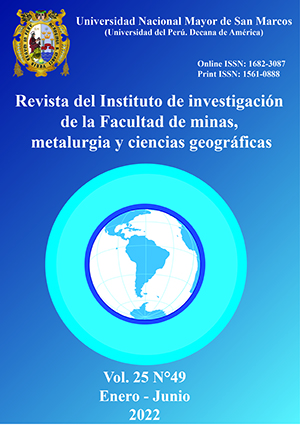Open tank leaching of arsenides from a lead smelter in the Central Highlands, Peru
DOI:
https://doi.org/10.15381/iigeo.v25i49.23028Keywords:
acid oxidative leaching, arsenic, arsenides, precipitation, scoroditeAbstract
The arsenic content of a smelter's gaseous emissions represents a serious risk to human health, as they are reported in soils and waters. Within a smelter's operations, by-products with high arsenic content recirculate indefinitely instead of being drained. In order to provide an environmental alternative, the present research work evaluates the Acid Oxidative Leaching process that uses the H2SO4 - H2O2 mixture to dissolve the arsenides, which must be completed with environmental removal by precipitation as Scorodite; a process known and accepted worldwide. The optimal parameters obtained are: 240 kg/t of H2O2, concentration of 120 g/L of H2SO4, L/S ratio of 9/1 and as iron contributor: 170 kg/t of copper tailings, with which solutions of 56% As and 90% Cu; item whose recovery pays for the process.
Downloads
Published
Issue
Section
License
Copyright (c) 2022 Luis Américo Rivera Del Valle, Vidal Sixto Aramburú Rojas

This work is licensed under a Creative Commons Attribution 4.0 International License.
AUTHORS RETAIN THEIR RIGHTS:
a. Authors retain their trade mark rights and patent, and also on any process or procedure described in the article.
b. Authors retain their right to share, copy, distribute, perform and publicly communicate their article (eg, to place their article in an institutional repository or publish it in a book), with an acknowledgment of its initial publication in the Rev. Inst. investig. Fac. minas metal cienc. geogr.
c. Authors retain theirs right to make a subsequent publication of their work, to use the article or any part thereof (eg a compilation of his papers, lecture notes, thesis, or a book), always indicating the source of publication (the originator of the work, journal, volume, number and date).























